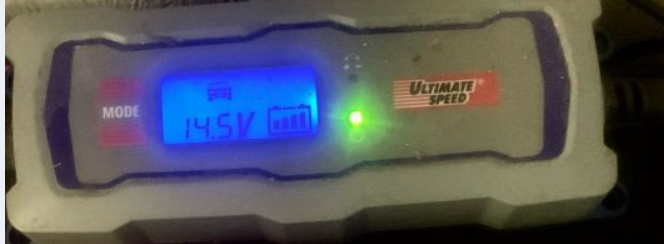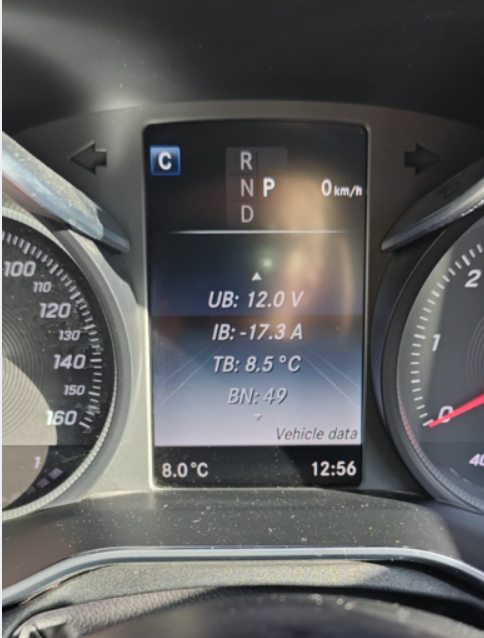All Activity
- Past hour
-
The battery number on my service sheet is MA001 982 81 08/26, suggesting it is an OEM Varta 80Ah AGM battery; but, it may be from any brand, so I will attempt to inspect it at some point. I believe it will be challenging to make a claim, particularly if it can be sufficiently charged to pass a battery assessment. I can envision them merely recharging it and exclaiming, 'See, it's functioning!' so rendering my trip to NW London, where I no longer reside, futile. There may be a two-year guarantee, potentially less than the manufacturer's, presumably to account for the part number being associated with several vendors.
-
Thank you, everyone. I believed at the time that the auxiliary capacitor was responsible for the start/stop function (I am uncertain about the specific roles of each component, to be honest), and as I was indifferent to that aspect, I neglected it. 😂 I will examine whether there is any warranty on the battery, which was installed during a service at a dealership. I am uncertain if the service sheet will provide relevant information, but I will explore further. I am unaware of the brand, to be honest, as I have never removed the cover. A typical travel exceeding 45 minutes sufficed to mitigate that warning for several weeks, and this remained true even lately. Recent occurrences of the notice appearing post-drive have led me to suspect a phantom drain. However, it currently appears that battery situation is more probable. The current plan is to get a Noco 5 charger, fully recharge it, and assess its status. The battery may have been defective from the outset. An AGM battery, even under less than ideal conditions, should last longer than 2.5 years.
-
I possess a large, antiquated Crypton 'Chargemaster' charger, originating from my late father's workshop. It is approximately the dimensions of a small filing cabinet and can provide around 400A, capable of starting a vehicle with a fully depleted battery, irrespective of its duration of inactivity. It is presently concealed within my storage container. Although it can provide a beneficial charge to a depleted battery in approximately 20 minutes, this practice is detrimental to the battery's longevity. However, it can facilitate your immediate needs in an emergency, provided you monitor the current input and reduce it slightly. If street parking necessitates the absence of a maintenance charger, an alternative is a solar panel charger, which can be positioned on the dashboard or parcel shelf. Higher-quality models can deliver a beneficial trickle charge sufficient to counteract the drain from car alarms and maintain battery levels. It is important to note that inferior models may be ineffective; however, investing in a moderately superior option could prove advantageous. These chargers must be connected to a continuously live point within the vehicle to supply power while the car is locked and inactive, typically accessible via a permanently live fuse in the fuse box.
-
If the car is little utilised, this may be the problem—insufficient usage to achieve a complete charge. Do you possess off-road parking, either in a driveway or garage, with access to mains power? In that case, acquiring a maintenance charger and consistently connecting the vehicle to it when not in use would likely be the solution. The conventional recommendation is to acquire a CTEK charger; however, more economical options exist from ALDI or LIDL. Their 'Ultimate Speed' chargers also feature maintenance and cold weather modes, effectively maintaining battery charge levels. They will not charge a fully depleted battery; for that purpose, I still possess an ancient Gunson 'dumb' charger that can revive a dead battery over the course of a day, after which I switch to the maintenance charger. I possess two inexpensive chargers from Aldi/Lidl to maintain two spare batteries in a charged state. The grey item cost approximately £10 around five years ago, while I believe I spent £12.95 for the other one a few weeks prior. The two batteries I am maintaining on charge originated from distinct vehicles; one was extracted from my W140 upon its disposal approximately four years ago, while the other was removed from my SL when I purchased a new battery for it last month. I was unaware of the age or history of that battery, despite its satisfactory performance in starting the car. I prefer not to enter winter with an uncertain battery. Both batteries can jump-start other vehicles or power tiny 12V devices temporarily.
-
The voltage measurements being conducted here are incompatible for assessing a battery's state of charge. Utilising the battery voltage as an indicator of a battery's state of charge is valid only when the battery is at rest and there is minimal or negligible current flow. Recall the initial automobile alarms that were activated due to the detection of a battery voltage decrease produced by the illumination of the interior light. The in-car battery voltage monitor consistently reflects the current draw, which might be beneficial for comparison analysis if one is aware of the appropriate healthy metrics. This method is ineffective for determining the state of charge of batteries according to standard published tables, as any substantial current draw will reduce the battery voltage, resulting in a fully charged battery not registering 12.6 volts or the appropriate fully charged voltage for its type. The appropriate method for utilising the published state of charge tables is to measure the voltage at the battery terminals while the vehicle is in a dormant state. The recent failure of a recently installed battery, which ceased functioning in stop-start mode a few months post-installation, suggests an issue with either the battery or the charging mechanism and warrants investigation accordingly. An OEM battery is expected to endure beyond 2.5 years, leading me to consider that the battery may have been deficient from the outset, which is a possibility. What is the duration of the battery warranty? I acknowledge that I am contentedly operating a vehicle with a battery that no longer facilitates the stop-start function, which ceased to function after 6.5 years of use.
-
My previous vehicle (ALFA) had a voltage of approximately 11.5v due to its failing battery, which resulted in numerous malfunctions, such as ABS and stability warning lights, as well as a flashing odometer. These issues were solely attributable to the low voltage and were resolved with the installation of a new battery.
-
12.6 volts indicates a fully charged state, while 12 volts signifies approximately 40% charge, or less than 40% if it is an AGM battery. Utilise a suitable charger to fully charge it and observe the results. 13.9 volts indicates that the alternator is functioning properly. The initial voltage of 11.7 V indicates it is less than 10% charged, rendering it effectively depleted.
-
Less than halfway through the drive, the IB decreases from approximately 8 to around 2.x and is rather stable thereafter. BN has scarcely grown, although it typically exhibits a significant gain after charging. Am I correct in assuming that if the alternator is defective due to inadequate charging speed, there would be additional symptoms present? Am I correct in assuming that if the auxiliary battery or capacitor were functioning effectively, there would be a distinct warning and the battery statistics would appear more favourable? Is it unusual or typical for an OEM battery to be depleted after 2.5 years, considering it operates in a suboptimal environment due to occasional use? I no longer believe I am experiencing a phantom drain, as the device does not seem to charge effectively, and warnings reemerge after hours rather than days. What are our thoughts? 😄
-
Greetings, everyone! I require assistance in diagnosing the issue with my battery. I am receiving the persistent yellow battery warning in the vehicle, which occasionally dissipates after a thorough drive but often reappears shortly thereafter. The battery endures a challenging existence, as the car is infrequently driven, resulting in limited time spent in a charged state. I apologise for the information overload; nonetheless, I am providing a timetable and battery statistics. A new primary battery was installed at Mercedes 2.5 years ago, and all is functioning well. A few months later, the start/stop function became dormant once more; nevertheless, everything else was functioning OK, and I was indifferent to the start/stop feature, so we continued as usual. Approximately one year ago, I experienced an event in which I left the vehicle parked on a frigid night with the battery warning illuminated, resulting in a failure to start and necessitating a jump start. Intermittently, particularly in winter when the battery is depleted, the vehicle displays a "collision assist not operational" message, which resolves autonomously after the battery is recharged. A few weeks prior, I drove the car for approximately 40 minutes, and several hours later, I received a battery warning. I took it out once more for an additional 20-30 minute trip, and there were no concerns with an extended interval before the next drive. Yesterday, the battery alert illuminated, prompting me to drive the car for 40 minutes. Several hours later, the battery warning reappeared... Operated the vehicle for an additional 20 minutes, and the warning reappeared later that evening. Operated the vehicle again this morning for 25 minutes and documented the battery statistics, which appeared suboptimal. Battery statistics: Prior to initiating the vehicle (by pressing the start button once to activate the radio and other systems) with a battery warning, I am uncertain whether the -15A reading is typical.
-
Consistently scan and adhere to codes, using them as a reference. Additionally, you may assess a sensor with a multimeter and proceed with its replacement if necessary. This model appears to lack a Tire Pressure Monitoring System (TPMS). A straightforward method to verify this is by examining the tire valves; if they are large and metallic, it is likely equipped with TPMS. Otherwise, the run-flat system depends on the wheel speed sensor to identify if one wheel is rotating slower than the others, triggering an alert. A dealer is not required; any reputable garage equipped with a proficient scanner can assist. Please provide your location, as some members here may be able to help if they are not too distant.
-
Greetings. First and foremost, The purported mechanic is uninformed, as ninth-generation Civics lack tyre pressure sensors. The system responds to wheel speed anomalies through the ABS sensors. This is likely the reason for the illumination of the ABS warning lights, among others. Consult a knowledgeable professional to scan the ABS system and examine the reluctor rings and ABS wheel speed sensors, then proceed accordingly.
-
Approximately two months ago, while driving home on an exceptionally hot day, the low tyre pressure warning light activated. I stopped to inspect the tires; there were no concerns. I restarted the vehicle, and the alert disappeared. Ten minutes later, the warning light illuminated once more, accompanied by many more warning indicators—ABS, tire inflation, power steering, etc.—yet there was no impact on the vehicle's handling. It has been somewhat sporadic since then; at times it activates, while at other times it does not. Occasionally, it is merely the single warning; at other times, there are many alerts. Presented the vehicle to a mechanic who connected it to diagnostic equipment and reported a warning for the tire pressure sensor (rear right) and a "power steering VSA system malfunction." He erased the codes, resulting in a temporary cessation, but the issue has since reoccurred. He also assessed the battery's condition and stated it was satisfactory. Has anyone else encountered a similar experience?
- Yesterday
-
https://www.ebay.co.uk/sch/i.html?_nkw=timing chain&campid=5338181132&customid=2518X1570512Xc076a4d88c761eda30903ca4067674e2&mkcid=1&mkrid=710-53481-19255-0&subId2=15&toolid=10001
-
Thank you. I will disassemble the pump this weekend to inspect it and the sprocket cam for signs of wear. A new Pierberg pump, following multiple model revisions, has ostensibly resolved the issues associated with earlier versions; yet, I remain apprehensive about the potential, albeit unlikely, risk of foreign objects entering the engine and interfering with the timing chain.
-
A friend installed a Honda Blackbird engine in a Smart Fortwo, and due to the Honda engine's insufficient vacuum for the brakes, he incorporated an electric vacuum pump from a Jaguar. That was effective, and while one might be inclined to believe that the smart can be quickly halted, it is not the case without a servo.
-
I have not experienced much success with Haynes manuals, as they often lack sufficient data on certain topics; but, I will attempt to utilise one.
-
https://uk.haynes.com/products/mercedes-benz-124-series-petrol-diesel-1985-aug-1993-haynes-repair-manual
-
The handbook can be ordered online from the Haynes website; refer to the link below.



